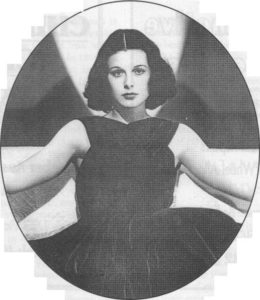- Author
- Butler, Alun
- Subjects
- Ship design and development, Naval technology, History - WW2
- Tags
-
- RAN Ships
- None noted.
- Publication
- June 1999 edition of the Naval Historical Review (all rights reserved)
She never walked off with any Oscars, but Hedy Lamarr knew a thing or two about torpedoes. For as long as Tony Loder can remember, he’d known that his mother, Hedy Lamarr, was a film star. But at seven years old, he suddenly discovered that she had an amazing secret locked away in her past. Not the usual Hollywood fare of sex, booze or drugs – his mother’s secret was far more remarkable. “We were going through some old boxes in the attic,” he recalls, “when she suddenly pulled out some old papers and said `Oh yes, I invented radio-guided torpedoes’.” Loder was too young to see anything weird in this at the time, but decades later, it seemed very different. “She was twenty years ahead of her time,” he says.

But Lamarr did more than simply invent a way of controlling torpedoes. In 1941, with avant-garde composer George Antheil, she was granted US patent number 2 292 387 for a “Secret Communication System” that used a new technique to conceal a radio message by sprinkling it across a wide range of frequencies.
With a simple mechanism based on the insides of a player piano, messages would jump or “hop” from one frequency to another at random, making it impossible to listen in or to jam the signal. Lamarr intended that the system would steer a torpedo remotely, guiding it towards a moving ship with no danger of interference from the enemy. Today, the technique they proposed – now called frequency hopping spread spectrum – lies at the heart of the latest communications systems, the revolution in mobile phones and could soon offer cheap wireless access to the Internet.
Their design overcame one of the biggest weaknesses of radio communications. Normally radio signals – the sort used for broadcasting music for instance – are transmitted in a narrow frequency band and picked up by carefully tuning the receiver to the same band. Unfortunately, this method is useless for sending secret communications; anyone can listen in, and worse, the signal is easily lost in the fuzz of background noise or can be blocked completely by a devious enemy.
Lamarr first learnt of the vulnerability of radio signals in the 1930s while she was married to Fritz Mandl, an Austrian arms dealer. Mandl was selling bombs, bullets and torpedoes to the rapidly expanding military forces of Germany and Italy – and was also keen to show off his beautiful young wife. Possibly to improve his chances of making a sale, she sat in on many of his meetings, where she heard that Mandl’s torpedoes often missed their target. What navies really wanted, she learnt, was a way to guide a torpedo as it raced through the water. Radio control fitted the bill, but if a torpedo relied on a single frequency, the control system could easily be jammed.
Steering a torpedo with a signal that hopped frequencies seemingly at random would make the signal unjammable. Enemy radio operators scanning across the airwaves would hear no more than a fragment of the signal in their headphones before the transmission hopped to another frequency and disappeared into background noise.
To work, both receiver and transmitter must “hop” in perfect synchronisation. This is where the innovative composer George Antheil came to Lamarr’s aid. The couple met at a Hollywood party and when Lamarr told Antheil about her idea, it turned out that he had already solved the synchronisation problem.
Sixteen years before, he had composed Ballet Mechanique, a musical piece written for aircraft propellers, wooden rattles, tin gongs and four synchronised player pianos. Antheil’s mechanical music made quite an impression: one reviewer described it as if “you were to listen to the notes of circular saws biting their way through steel, mixed with the crash of a steel die plant.” Crucially, the pianos used synchronised motors to drive matching paper rolls punched with holes to indicate when the pianos should play a note.
Antheil and Lamarr realised a transmitter and receiver could be synchronised in the same way. In their patent, the transmitter and torpedo each contained a paper roll punched with an identical pattern of random holes, a motor and mechanical switches. As the torpedo was launched, the motors would drive the rolls and the holes in the paper would change the frequency settings of both the transmitter and receiver in much the same way that a push-button radio changes radio station.




